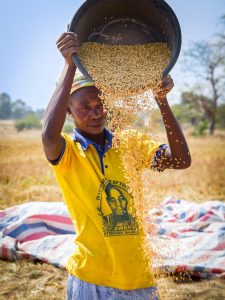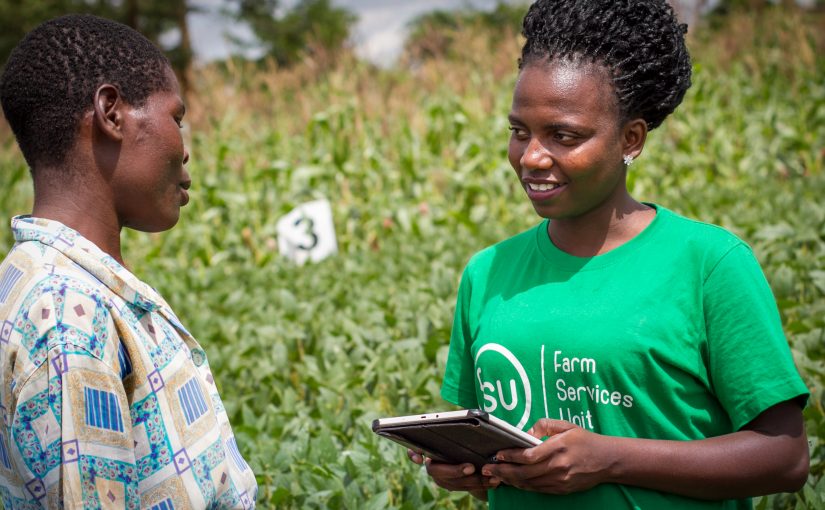Call me old fashioned, but I firmly believe that the best way to support small farmers is through field officers. These staff are the crucial link between an agribusiness and rural farmers and the relationship that they build is critical for successful contract farming models. Half-hearted attempts to provide support, with field officers too thinly spread, are doomed to failure – they do not secure farmer loyalty nor achieve meaningful improvements in productivity.

I feel even more certain of the benefits of investing in field officers following a recent trip to Northern Ghana. The DFID-funded MADE programme has encouraged agribusinesses to use ‘farm enterprise advisers’ (FEAs) to engage with smallholder farmers. Some of these businesses are seeing smallholder land usage and yields both double over a two year period and report that farmers are queuing up to join their schemes. Recoveries of crops (to pay input loans) are typically over 90 percent. Clearly not all of these results can be attributed to the FEAs, but they have certainly played a major role, including training farmers and ensuring they have quality inputs. For more on this model see this MADE infographic business case.
There is a school of thought that says digitisation can replace the need for field officers / extension workers; more and more farmers have feature phones and can subscribe to digital sources to receive agronomic information directly. My personal view is that smartphone coverage is not as widespread nor growing so fast among low-income rural farmers than people would like to believe. The stories on digital innovation in the press are usually from high value crops in formal value chains, such as coffee or cocoa, and these represent less than 10 percent of the world’s smallholder farmers. Moreover, data coverage, phone charging and literacy remain significant barriers for small farmers on top of the cost of buying a smartphone. Farming is a complex undertaking and using advice from videos and off the internet is fraught with risks of misunderstanding and of trust. That is not to say that the use of digital technology to help farmers does not have value, but I think for the foreseeable future it is best blended with a human intermediary.
Part of what Smallholdr’s software aims to do is to empower field officers to do their jobs better. Not only do we see them as data collectors, but we see them as being some of the most important users of the information that is captured and assimilated in the Smallholdr database. Here’s our top ten ways that field officers can use data – immediately as they capture it and also data that is synced from the Smallholdr database back down to their Mobile App to enhance their work:
- Rapid identification of farmers: no more asking for names – simply scan the farmer’s QR code card and their face and details pop up on the app (online and offline).
- Providing tailored advice: core information about each farmer is synced onto the app and is available to help field officers tailor advice – e.g. by knowing what issues a farmer had in the previous season or being able to see the results of a local soil test.
- Agronomic planning: for example, historic information on farmers’ fields can help plan what crop to plant where in the current season according to rotation preferences.
- Up to date input information: different inputs and their prices can be updated on the Smallholdr database by managers and synced automatically to the app so that a field worker has an up to date list to use and can record the distribution to each farmer.
- Calculations to assist planning: for example, the total size of land being farmed for each crop can be used to automatically calculate the amount of each input a farmer needs, or the total yield forecast for a farmer can be calculated using a variety of information the field officer has collected over the growing period.
- Managing loans and payments: the value of input loans and payments for offtake can be calculated in the app and a field officer will be able to see the totals of all loans and payments for each farmer.
- Logistics management: Farmer information on the app can also help field officers to plan logistics – e.g. the delivery of inputs or the collection of crops. For example, for a honey company field officer can see how many buckets are with each beekeeper to plan collection and transportation to the nearest warehouse.
We hope you found this blog useful – if you have any questions of comments please do not hesitate to drop us a line!
Get in touch
If you would like more information on how Smallholdr can help you manage your field team and empower them to work with smallholders or beekeepers more effectively, please get in touch!
[button link = “http://smallholdr.com/contact”] Contact Us [/button]
